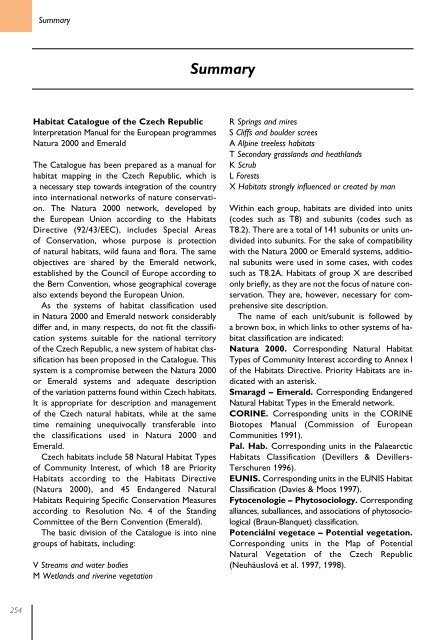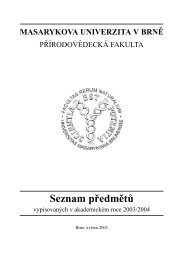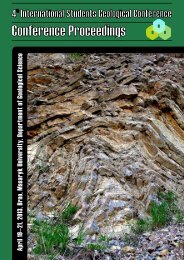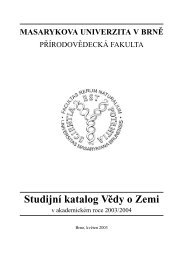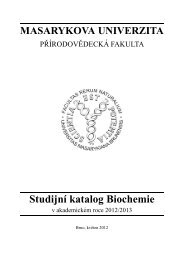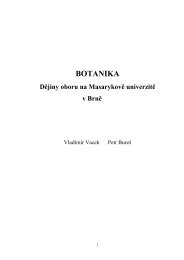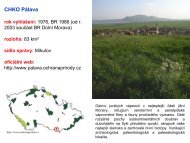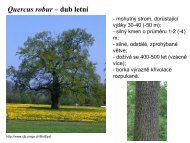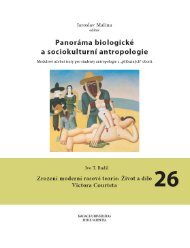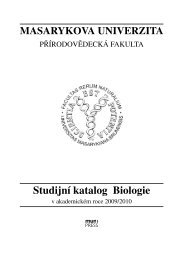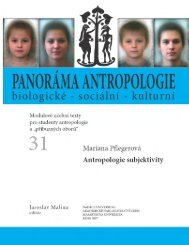You also want an ePaper? Increase the reach of your titles
YUMPU automatically turns print PDFs into web optimized ePapers that Google loves.
Summary<br />
Summary<br />
Habitat Catalogue of the Czech Republic<br />
Interpretation Manual for the European programmes<br />
Natura 2000 and Emerald<br />
The Catalogue has been prepared as a manual for<br />
habitat mapping in the Czech Republic, which is<br />
a necessary step towards integration of the country<br />
into international networks of nature conservation.<br />
The Natura 2000 network, developed by<br />
the European Union according to the Habitats<br />
Directive (92/43/EEC), includes Special Areas<br />
of Conservation, whose purpose is protection<br />
of natural habitats, wild fauna and flora. The same<br />
objectives are shared by the Emerald network,<br />
established by the Council of Europe according to<br />
the Bern Convention, whose geographical coverage<br />
also extends beyond the European Union.<br />
As the systems of habitat classification used<br />
in Natura 2000 and Emerald network considerably<br />
differ and, in many respects, do not fit the classification<br />
systems suitable for the national territory<br />
of the Czech Republic, a new system of habitat classification<br />
has been proposed in the Catalogue. This<br />
system is a compromise between the Natura 2000<br />
or Emerald systems and adequate description<br />
of the variation patterns found within Czech habitats.<br />
It is appropriate for description and management<br />
of the Czech natural habitats, while at the same<br />
time remaining unequivocally transferable into<br />
the classifications used in Natura 2000 and<br />
Emerald.<br />
Czech habitats include 58 Natural Habitat Types<br />
of Community Interest, of which 18 are Priority<br />
Habitats according to the Habitats Directive<br />
(Natura 2000), and 45 Endangered Natural<br />
Habitats Requiring Specific Conservation Measures<br />
according to Resolution No. 4 of the Standing<br />
Committee of the Bern Convention (Emerald).<br />
The basic division of the Catalogue is into nine<br />
groups of habitats, including:<br />
V Streams and water bodies<br />
M Wetlands and riverine vegetation<br />
R Springs and mires<br />
S Cliffs and boulder screes<br />
A Alpine treeless habitats<br />
T Secondary grasslands and heathlands<br />
K Scrub<br />
L Forests<br />
X Habitats strongly influenced or created by man<br />
Within each group, habitats are divided into units<br />
(codes such as T8) and subunits (codes such as<br />
T8.2). There are a total of 141 subunits or units undivided<br />
into subunits. For the sake of compatibility<br />
with the Natura 2000 or Emerald systems, additional<br />
subunits were used in some cases, with codes<br />
such as T8.2A. Habitats of group X are described<br />
only briefly, as they are not the focus of nature conservation.<br />
They are, however, necessary for comprehensive<br />
site description.<br />
The name of each unit/subunit is followed by<br />
a brown box, in which links to other systems of habitat<br />
classification are indicated:<br />
Natura 2000. Corresponding Natural Habitat<br />
Types of Community Interest according to Annex I<br />
of the Habitats Directive. Priority Habitats are indicated<br />
with an asterisk.<br />
Smaragd – Emerald. Corresponding Endangered<br />
Natural Habitat Types in the Emerald network.<br />
CORINE. Corresponding units in the CORINE<br />
Biotopes Manual (Commission of European<br />
Communities 1991).<br />
Pal. Hab. Corresponding units in the Palaearctic<br />
Habitats Classification (Devillers & Devillers-<br />
Terschuren 1996).<br />
EUNIS. Corresponding units in the EUNIS Habitat<br />
Classification (Davies & Moos 1997).<br />
Fytocenologie – Phytosociology. Corresponding<br />
alliances, suballiances, and associations of phytosociological<br />
(Braun-Blanquet) classification.<br />
Potenciální vegetace – Potential vegetation.<br />
Corresponding units in the Map of Potential<br />
Natural Vegetation of the Czech Republic<br />
(Neuhäuslová et al. 1997, 1998).<br />
254


